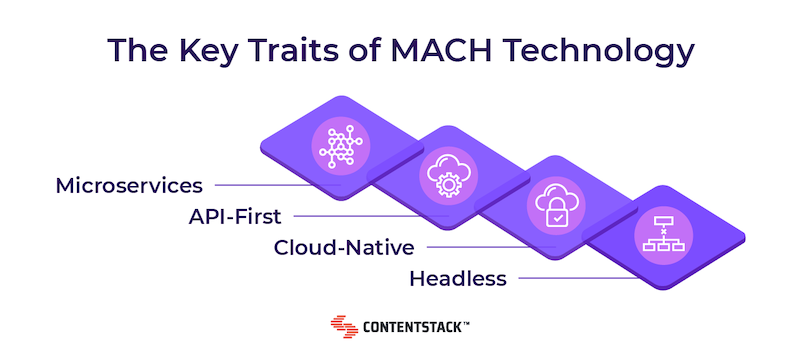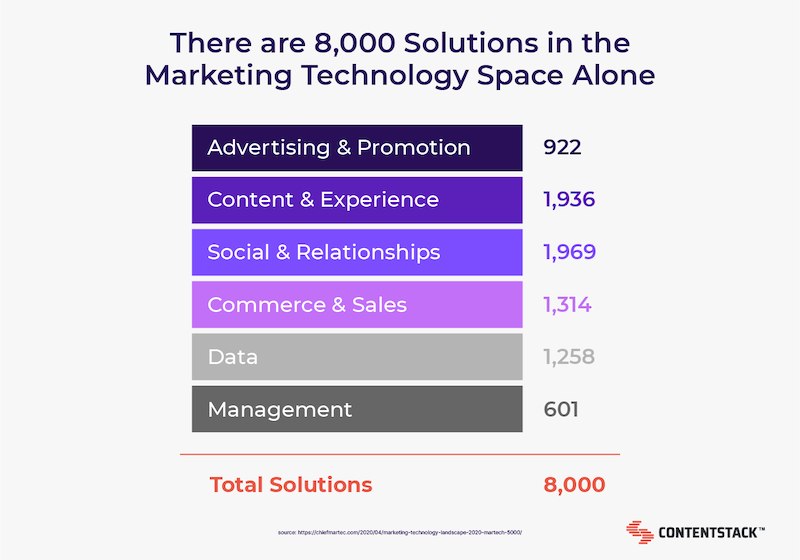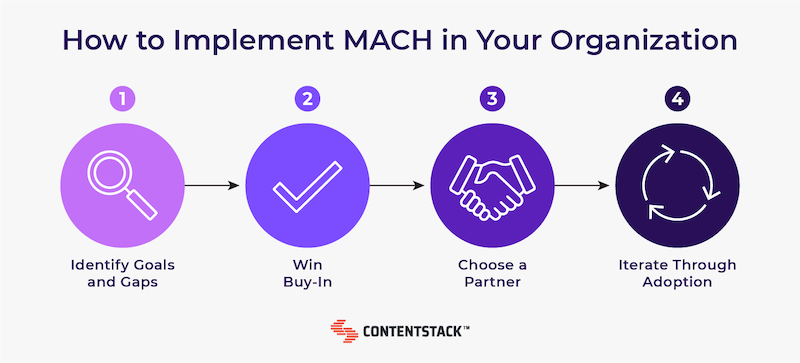As competitive pressures drive the need for digital transformation, enterprises have a mind-boggling number of factors to weigh when growing their digital experience. This decision-making process is especially tough for established brands with legacy infrastructure that represents years of investment in capital and human expertise.
While the number of martech tools continues to explode, the types of solutions that can support your business transformation are more clear-cut. You can choose to stay wedded to your traditional, monolithic system —or you can pursue a modern digital infrastructure that enables your business to integrate the best of these new technologies and adapt to market forces.
If you find yourself caught between the two, you’re not alone. The prospect of embracing a new way of developing and delivering digital services can feel overwhelming. The truth is, if you’re already considering ways to accelerate your growth with modern digital tools, you’re more ready than you think you are to embrace the MACH approach.
But what’s MACH? And are you ready to go all the way when it comes to MACH?
The following article explains MACH technologies and helps you assess whether MACH is right for your enterprise.
How MACH Works Magic in Your Tech Stack
MACH technology is microservices-based, API-first, cloud-native, and headless. Far from just a fancy buzzword that invokes scenes of jet fighters, MACH technologies have several high-performance features:
Microservices deliver each microservice’s functionality by connecting it to the desired endpoints.
Application programming interfaces (APIs) deliver each microservice’s functionality by connecting it to the desired endpoints.
Cloud-native infrastructure gives you scalability that legacy enterprise systems don’t have.
And a headless digital system, such as a headless content management system (CMS), separates the front-end presentation from the back-end programming. This separation enables development flexibility and breaks down the data silos that stifle collaboration and enables omnichannel delivery.

By design, MACH technologies are modular and scalable, with the ability to swap services in and out to meet evolving business needs. This is precisely why the MACH approach is gaining ground. A recent report by Forrester found that 76% of organizations believe that microservices are a crucial business agenda, something that’s also reflected in how organizations are planning to invest. The global market for cloud microservices, which estimates put at $810M for 2020, is projected to reach $2.8B by 2027 — growing at a CAGR of 19.2% from 2020 to 2027.
The magic of MACH comes from the way its four key elements work together to make enterprises more agile and innovative. In particular, MACH technologies excel at meeting essential business needs that have become inherent in today’s business environment. Three key things drive most enterprises to consider MACH:
- Speed: You want to execute tasks and implement services faster
- Outcomes: You want to deliver an exceptional customer experience that your current legacy architecture can’t handle
- Processes: You need a tech stack that eliminates data silos and promotes collaboration
If that sounds like virtually everyone in today’s market, you’re right. In our digital-first world, brands need to engage with consumers on multiple devices and channels, and the rules are being rewritten every day. The good news? With MACH, you can draw your roadmap to success.
You’re Ready to Go MACH If...
Not sure if you’re quite ready to go MACH? It all depends on whether or not the following statements ring true.
You Have Big Plans for Your Omnichannel Strategy
If you operate across multiple channels and customer touchpoints — or aspire to — the MACH framework accelerates your ability to innovate with traditional and digital touchpoints, as well as seize new opportunities at any point along the customer journey.
The microservices at the foundation of the MACH approach are agile and modular, which means you’re not stuck with the limitations of a one-size-fits-all enterprise suite. One of the biggest reasons for going MACH is the flexibility to choose whichever services you want to deploy.
With microservices, you can quickly create and deploy small (as in micro) function-specific solutions for new channels and customer touchpoints without lengthy and expensive lead times because they use less code.
Microservices also allow you to experiment and innovate without impacting your other core services, generating less risk and more reward for your effort. Together with a headless CMS, this eliminates channel silos and allows you to deliver a consistent customer experience across touchpoints, which drives brand loyalty.
Even better? MACH technologies are inherently vendor agnostic, which gives brands the freedom to innovate, test, and refine quickly — all while creating a custom tech stack that future-proofs their investments and delivers a stellar user experience.
Whether you develop something new in-house or you want to try a new best-of-breed tool, MACH technologies empower your team to meet emerging needs with the agility that your customers — and your CEO — expect.

You Need Scalable Infrastructure That Grows Along With You
If your enterprise needs to react to unexpected market changes or disruptions that call for fast implementation of new solutions, MACH can equip you to do it fast.
Adopting microservices lets you take a modular approach to gradually replacing your legacy architecture at a pace that aligns with your business needs and budget. Even if you run multiple platforms that need to talk to each other, the API-first approach makes integration simple, with the added benefit of giving developers the freedom to choose the best front-end technology for a given problem and simplify development with a unified logic.
Your Business Requires Lightning-Fast Speeds and Reliable Uptime
Using microservices also allows you to implement and manage new features and functionality seamlessly, avoiding the negative cascading impacts if an update goes sideways.
This means no more bundling new features or upgrades into complex releases and a blissful end to complicated recompiling and rebuilding. Cloud services also leverage multiple data centers across time zones to give you the flexibility to handle traffic fluctuations that would grind legacy systems to a revenue-stopping halt.
You Have Multiple Teams to Serve
If you have several people across departments working together or needing access to the same data, MACH will accelerate collaboration. The headless architecture underpinning MACH-ready technology makes it easy to ensure that individuals and teams have access to the tools and functionality they need, thanks to well-constructed APIs to break down data silos.
You’re Always Thinking About Keeping Costs In Check
If your business needs surge capacity to handle volume fluctuations (think holiday shopping), MACH can save you a lot of headaches. MACH’s cloud-native design lets you power up to meet the Black Friday shopping rush without having to pay for surge capacity when you don’t need it. A consumption-based model is also an excellent choice for business models that recognize that increased transactions mean increased costs — and vice-versa.
Instead of asking yourself if you can afford to ditch your monolithic legacy system and go MACH, considering the monetary and morale cost of maintaining a legacy system, you should be asking yourself if you can afford not to.

How to Implement MACH in Your Organization
At its core, MACH allows enterprises to use technology the way it’s meant to be used: To enable business success, not just to be another sunk cost. And once they see it through this lens, most organizations are in a good mental space to go MACH. Now, follow these guidelines and get in a good organizational space for spinning up your first-ever MACH project.
Identify Your Goals and Gaps
Starting your MACH journey begins with knowing what you want to achieve and what gaps prevent you from getting there. Do you have urgent problems that need solving to address your current business needs, such as adding critical functionality missing from your current stack? Or are you looking for ways to accelerate your growth and future-proof your next investments in your tech stack so you can turn on a dime if the need arises? Thoughtful questions like these — and plenty of others that are more specific to your business — will help you start outlining your goals when you go MACH.
Now how close can you get to achieving those goals with what you already have? What’s missing — and how will MACH help you integrate it? With your goal in mind, these kinds of questions will empower you to identify the gaps you intend to fill with your MACH technologies.
Win Organizational Buy-In
Implementing a MACH approach is an excellent way to drive growth and innovation in your brand, in large part because it touches every aspect of how you operate as a business.
However, digital transformation is as much about people as it is about technology. That means you need buy-in throughout your organization to implement MACH successfully. From the CEO and CFO who hold the purse strings to the developers and content creators who will be working with the new solutions you introduce, your MACH journey will be much smoother if everyone understands the goals and has a chance to contribute to the process.
The consultative process often reveals even more opportunities to innovate with new technologies that many assumed were out of reach.
Find an Implementation Partner
Look, we’re not here to sugarcoat reality and say that the process of taking your whole organization MACH is an easy one. We’re here to say mostly the opposite. Making the transition to MACH requires particular expertise — both with the transformation itself and the ground-breaking technology MACH entails.
So, look for a transformation partner that has that expertise. The ideal partner won’t just provide the staff you need to make the transition — though that’s a super important element — but will also continue to support you as you dismantle more of your legacy monolith to let new technology take root.
For six powerful tips that will help you choose an ally in your MACH transformation, read our blog “How to Choose the Best Partner to Transition Your Technology to MACH.”
Iterate Your Way to Full Your MACH Adoption
We’re big fans of the agile approach to everything from marketing to development to, now, MACH implementation.
As such, we recommend an iterative approach to “going MACH,” in which you tackle small projects, replace specific software solutions, or improve minimal areas of the business at a time.
By doing so, you can create a cycle in which stakeholders can see the changes and weigh in on what’s working and what isn’t working in almost real-time. With each iteration, you and your implementation partner will get smarter about what your organization wants with MACH and implement more efficiently over time.

Want to see a MACH technology implementation project unfold right before your very eyes? Check out Project Spyglass, Valtech and Contentstack’s four-week augmented reality effort:
- How to Concept and Pitch an Augmented Reality Demo (in 1 Week or Less)
- Augmented Reality for Retail: From Concept to Game Plan (Week 1 / 3 of Development)
- Augmented Reality Frameworks for an Enterprise Web-Based AR Application
- Development of an Augmented Reality Retail Skincare POC: Content Modeling and Interaction Building (Week 2/3)
And be sure to stay tuned to the Contentstack blog for more updates as Project Spyglass continues to develop!
Get Familiar With the Market Before You Go MACH
If reading this article has you motivated to go MACH, check out our free MACH Evaluation Checklist to help you quickly assess whether that cutting-edge tech you’re looking at really follows the MACH principles to which you want to adhere.
Dive even deeper by downloading our ebook, Break the Replatform Cycle with MACH Enterprise Architecture, to learn more about MACH, see if MACH is a good fit for your enterprise, and get advice from digital leaders who have found success with MACH
